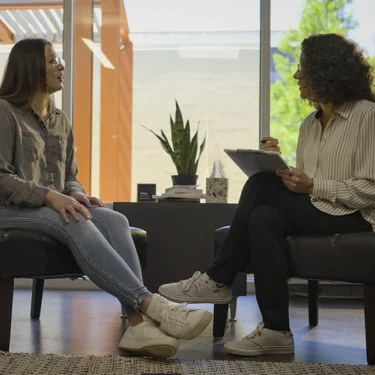View Point Health Director of Core Services Julie Solinski (pictured) engages in a video conference with co-workers.
Editor’s Note: The coronavirus outbreak has led practitioners to rethink behavioral health care treatment and the delivery of service. In this series, we will address the questions and concerns raised by providers and offer tips and suggestions to help you cope with problems caused by the pandemic.
It took a public health crisis to convince federal regulators to allow patients and providers to turn to telehealth.
Now National Council for Mental Wellbeing members say there’s no reason to turn back.
Changes in state and federal telehealth regulations since the beginning of the COVID-19 pandemic have accommodated the movement of behavioral health care treatment and services online. Now, the Centers for Medicare and Medicaid Services (CMS) allows providers to bill Medicare and Medicaid for a wide range of telehealth services for as long as the pandemic lasts.
The National Council policy team has completed an extensive review of telehealth policies and practices.
“We’ve seen more progress on telehealth in the last five weeks than in the last five years,” National Council for Mental Wellbeing President and Chief Executive Officer Chuck Ingoglia said during an April 21 virtual town hall meeting with members.
Regulatory Changes Fuel Online Migration
For many providers, the pandemic provided an unexpected opportunity to take the next step in their migration to telehealth services.
Northwestern Mental Health Center, which serves an eight-county area in northern Minnesota, began providing tele-psychiatry services in the early 2000s.
“We already had the infrastructure in place,” said Shauna Reitmeier, chief executive officer at Northwestern Mental Health Center. “There was an additional investment that we had to make to support more telehealth, but we already had a great foundation. The pandemic meant we just moved online more quickly.”
As a result, Northwestern Mental Health Center increased its billing for online services from 4% of claims in December 2019 to 23% in March 2020.
Now, the clinic delivers 90% of its services via telehealth.
At Sheppard Pratt Health System, based in Towson, Maryland, about 10% of their patients received behavioral health care treatment and services through telehealth prior to the pandemic. That’s grown to 80% since the public health crisis began.
“It’s been a dramatic change. We had some services that were completely face to face prior the pandemic, and now 90% of those programs are delivered through telehealth,” Sheppard Pratt Chief Operating Officer Jeff Richardson said.
Sheppard Pratt also leverages its telehealth infrastructure to keep staff members – who are distributed broadly across the state – feel more connected. Now the clinic is searching for new ways to be innovative with telehealth services, and it has started providing clients with mobile phones.
“What we’d like to do is purchase the phones in mass,” Richardson said. “We want to create an infrastructure to connect with the people we care about.”
Since Sheppard Pratt had some telehealth services in place before the pandemic struck, having more clients rely on mobile phones to connect with practitioners won’t overwhelm a staff that’s already digitally savvy.
Baptism by Fire
For other providers, the pandemic represented a rapid, seismic shift to their priorities.
View Point Health, in Lawrenceville, Georgia, already planned to expand the telehealth services it provides through its community-based services and outpatient clinics for bilingual services.
View Point Clinical Director Makini Corlette scheduled a call with Zoom on March 12 to discuss training and technical issues – they were using multiple platforms to support telehealth initiatives.
On March 13 the president declared a national emergency, and View Point’s executive team met to make a new plan.
“We were going to take the next year to start this,” View Point Chief Executive Officer Jennifer Hibbard said. “We just ramped it all up in a week.”
That meant developing an aggressive training schedule for employees throughout View Point, which serves clients in a three-county area outside of Atlanta. By April 4, View Point transitioned the majority of its outpatient clinicians and nurses to remote work. Its speedy transition meant that clinicians had to provide tech support to clients, as they learned to adapt to telehealth together. In three weeks, View Point went from offering telehealth services to 8% of its outpatient clients to 67% of its outpatient clients.
Even though View Point is offering fewer services overall than before the pandemic, telehealth helped the clinic quickly rebound from an initial drop off in client visits and begin generating revenue as demand picked up and clients embraced the convenience and safety of telehealth. That demonstrated that telehealth not only provides clinical value to patients, it also provides financial value to clinics.
For telehealth veterans like Reitmeier, View Point’s experience is emblematic of a typical clinic’s journey.
“There are going to be challenges, but you just have to do it,” she said. “You’ve got to be honest with your clients and say, ‘we’re both doing this together for the first time, and we’re in it together.’ That’s the motto right now – we’re in this together. It’s pretty elementary, but you just have to do it.”
Making Telehealth the New Normal
Nearly two months after the declaration of a national emergency that gave telehealth its momentum, providers have a hard time imagining that they can stop using telehealth and go back to the old way of doing business.
“I think I was of the camp that telehealth was useful, but that face to face is always better,” Hibbard said. “I think I have learned from this experience that that’s not necessarily true. Having this opportunity to really utilize this service fully has really taught me a lot, and I think we shouldn’t go back to the way it was. We need to take this opportunity to see how we can improve access and allow some level of telehealth to remain in place.”
To meet that goal, providers must convince state and federal regulators to make the regulatory changes permanent. That includes changes to allow for coverage for audio-only services because mobile phones represent the only connection to providers for so many clients, particularly the elderly and the low-income Americans.
“There’s always been a digital divide. The pandemic is making it more pronounced,” Richardson said.
The National Council and other organizations on April 27 asked U.S. Department of Health and Human Services Secretary Alex Azar to lift the current Medicare prohibition on audio-only telehealth to allow access to a range of mental health services by telephone and ensure they are reimbursed the same as an in-person visit.
Maintaining the current approach to telehealth, free of burdensome regulations, will keep barriers to access low. Providers also say the nation’s current approach to behavioral health care delivery could also improve the health of patients, who appear more likely to keep their appointments with providers because of the convenience and safety telehealth provides – especially during the pandemic.
“We have a 73-year old client who is connecting with us through Zoom,” said Mike Garrett, chief executive officer at Horizons Mental Health Center, in Hutchinson, Kansas. “Once he figured it out, he just loved it. He said, ‘I may never want to come into the office again.’”
Guest Author
Senior Writer


